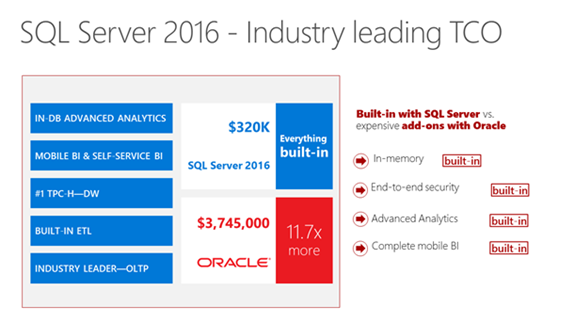Five reasons to run SQL Server 2016 on Windows Server 2016 – No. 2: Performance and cost
This is the second blog in a five-part series. Keep an eye out for upcoming posts and read the first post in the series, Five reasons to run SQL Server 2016 on Windows Server 2016, part 1.
Imagine you’ve just bought a super powerful car with built-in advanced technology to make it perform at its highest. You want to take full advantage of all that horsepower and even turbocharge it, while at the same time get great mileage. That’s what you get when you run SQL Server 2016 on Windows Server 2016: unmatched performance at the lowest cost.
By modernizing both your SQL Server data platform and your Windows Server OS, you can gain major cost savings and unprecedented performance boosts for workloads such as storage, business intelligence, and analytics. The strength of this combination has been shown in independent benchmark testing. As you can see in Figure 1, SQL Server 2016 on Windows Server 2016 leads the industry in both performance and price/performance ratio.
Figure 1: Best-in-class performance and price/performance ratio [1]
You can get these amazing results from a few key features that are built into the new versions:
- On the data platform side, SQL Server 2016 delivers in-memory performance, which gives you the power to run queries faster than ever before.
- Windows Server 2016 turbocharges this with Persistent Memory (aka Storage Class Memory), which provides 3x latency improvement.
- Storage Spaces Direct in Windows Server 2016 allows use of industry-standard servers with local storage as a highly available, scalable alternative to expensive storage area networks (SANs) — with read speeds that can exceed 25 GB/second.
SQL Server 2016 in-memory OLTP and 24 TB of Windows Server 2016 memory built in
In-memory processing was introduced in SQL Server 2014, and improvements in SQL Server 2016 make it much easier to accelerate your new, and now also your existing, applications. Revving up the speed potential of in-memory, Windows Server 2016 has built-in capability to provide in-memory with 24 terabytes of available server memory. Plus, new CPU maximums have been increased by three times so that you can run up to 640 CPU cores.
Windows Server 2016 Persistent Memory and Storage Spaces Direct
SQL Server professionals know that database transactions can be gated by log write speed. If the log is faster, more database updates are possible. Windows Server 2016 helps solve this with Persistent Memory, again adding direct value when you run SQL Server 2016 on Windows Server 2016.
When you think about significant cost savings over traditional storage, you’ll be interested to know that the new Windows Server 2016 Storage Spaces Direct lets you use local storage to create highly scalable and flexible storage solutions as shown in Figure 2. The ability to aggregate locally attached storage across the nodes in a failover cluster means you can deploy very large and highly available pools of storage from types of devices that you could not use before, such as inexpensive SATA SSD, and cutting-edge solutions like NVMe flash, which can plug directly into the PCIe bus inside the machine to create an NVMe fabric. Now SQL Server can scale to huge memory.
Figure 2: Enormous cost savings and blazing speed with Storage Spaces Direct
Persistent memory is a state-of the-art new technology, and Windows Server 2016 is exposing it for the first time. SQL Server is in lockstep with the innovation so you can exploit it to gain the fastest speed at the lowest cost. If you’re tied to hugely expensive third-party solutions, you can certainly appreciate the enormous value this brings.
Get it all!
SQL Server 2016 features are built in. You get great performance at less than one-tenth of the total cost of using Oracle to run the same transactional, data warehouse, data integration, business intelligence, and advanced analytics workloads. [2] With a Windows Server 2016 license, you also get everything built in: Hyper-V and advanced storage capabilities with no need to buy separate third-party storage solutions or virtualization technologies.
It’s all built right in. By listening to customers and creating new capabilities in both SQL Server 2016 and Windows Server 2016, Microsoft is tuning up your super vehicle to help get top performance and winning efficiency. Let ‘er rip!
To learn more, read the SQL Server + Windows Server Better Together white paper. Or try it out for yourself:
Read more
- Five reasons to run SQL Server 2016 on Windows Server 2016, part 1
- Five reasons to run SQL Server 2016 on Windows Server 2016, part 3
- Five reasons to run SQL Server 2016 on Windows Server 2016, part 4
- Five reasons to run SQL Server 2016 on Windows Server 2016, part 5
_____________________________________________________
[1] Qualifications and references for TPC-H results: These are for nonclustered TPC-H results and are valid as of March 1, 2017. The first bar is for the Cisco result . The second bar is for the Lenovo result. The third bar is for the HPE result. The price/performance references are valid as of March 1, 2017, and details on the referenced results can be found at:
#1 nonclustered 1TB performance
#1 nonclustered 3TB performance
#1 nonclustered 30TB performance
#1 nonclustered 1TB price/performance
#1 nonclustered 3TB price/performance
#1 nonclustered 10TB price/performance
#1 nonclustered 30TB price/performance
#1 TPC-E price/performance
[2] http://www.oracle.com/us/corporate/pricing/technology-price-list-070617.pdf




